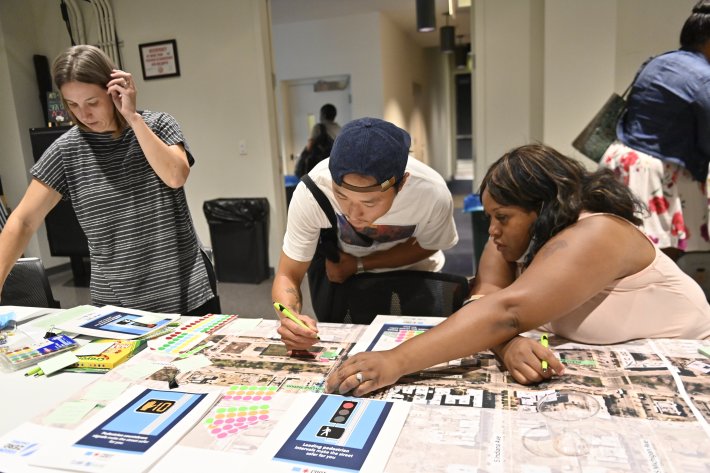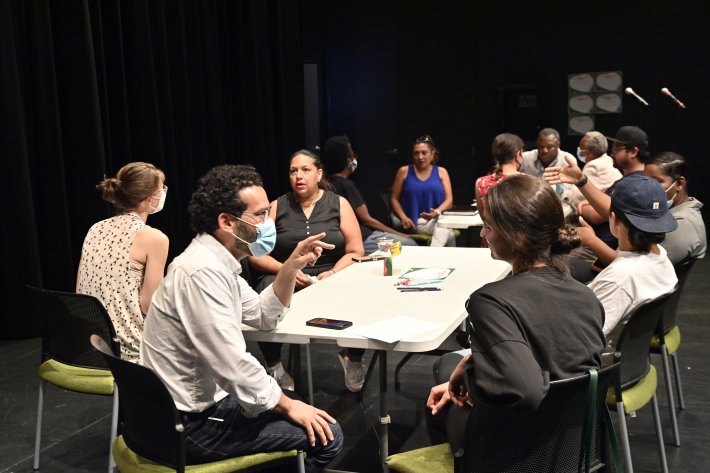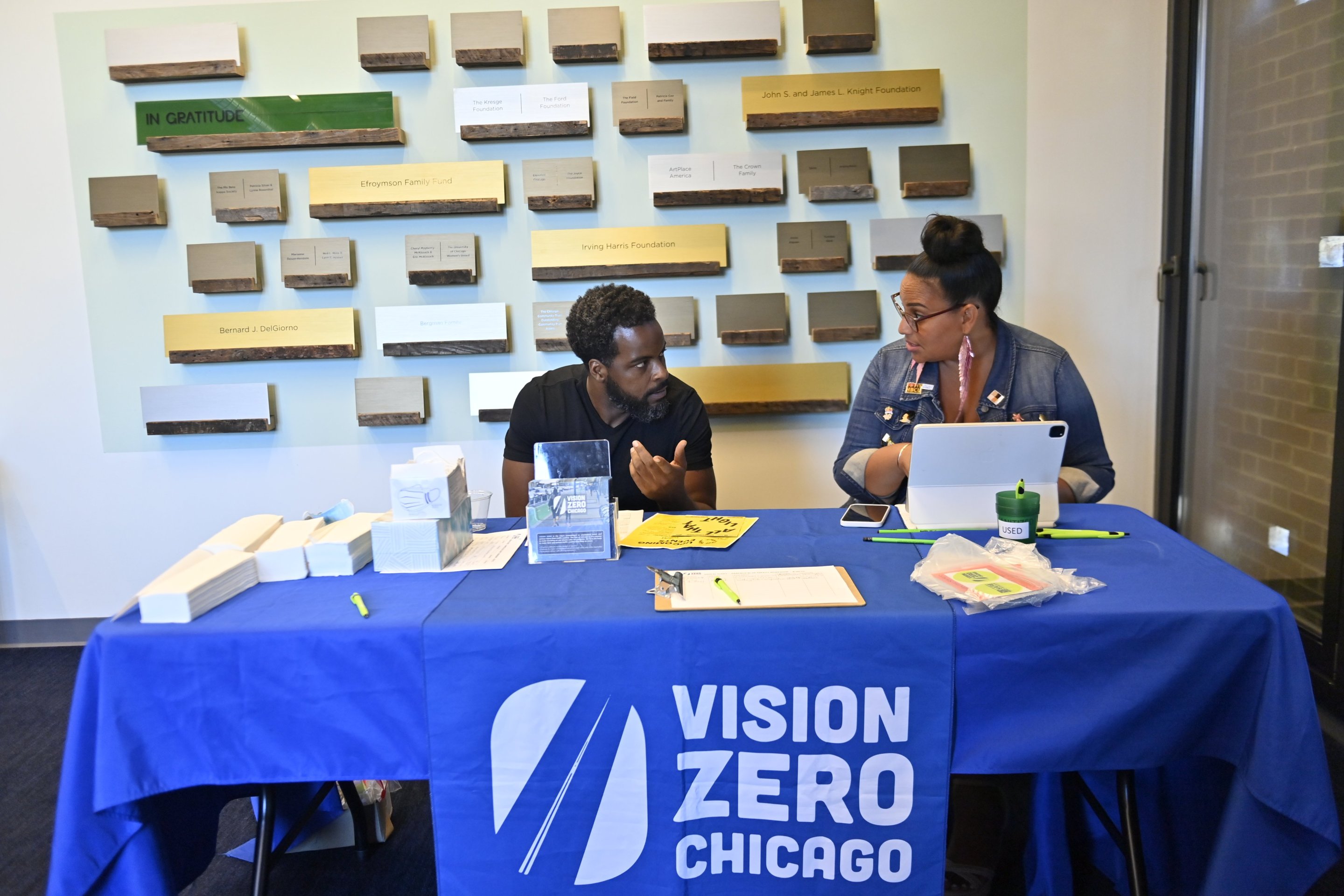On Wednesday August 30th, the Chicago Department of Transportation held a traffic safety workshop focused on Garfield Boulevard in the Washington Park neighborhood. The workshop was a continuation of the agency’s Vision Zero Southside initiative. A roundtable was held in February of this year to introduce the Vision Zero initiative to area residents. At Wednesday’s workshop, CDOT Commissioner Gia Biagi shared the story of her grandmother’s “porch sitting,” as a way to emphasize the importance of local knowledge in understanding context. She explained that all the data in the world will not paint a complete picture of how a street serves the people who live and travel along it. Vision Zero program manager, Michael Kent, explained the process of convening stakeholders over the past year through online meetings and in-person events. He also shared that, unlike in years past, the City has money in the budget to implement safety projects. Projects that reduce vehicle speeds, protect people walking and biking, and improve transit are high priority.
Garfield Boulevard is a major thoroughfare that bisects the Washington Park community. It is part of the historic boulevard system, connecting Washington Park and Sherman Park to Western Boulevard. It extends east and west as 55th Street to connect to Midway Airport and University of Chicago, with access to I-90. It is part of the National Highway System – a federal designation of roadways that are eligible for certain funds that have been identified as important to the economy, for defense purposes, and overall mobility. It has six travel lanes, a grassy median, and parking lanes, making it extremely wide and difficult for people to get across. CDOT has identified it as a high crash corridor and said that the number of cars traveling along it can be served by fewer lanes.
Wide roadways with low traffic volumes encourage speeding, which is a major factor in the severity of crashes. According to Illinois Department of Transportation’s Getting Around Illinois website, Garfield Blvd. has about 27,400 cars traveling on it daily. A roadway reconfiguration down to one lane in each direction with center turn lanes is recommended for roads with fewer than 20,000 daily vehicles, not the case here. Multiple attendees described speeding cars crashing into buildings or ending up on the sidewalks. The road is designated on CDOT’s network as a bike route, but people in attendance said they avoid it because it is too unsafe. Some people ride their bikes on the sidewalks if they must travel along Garfield, but this is problematic when CPD has been known to give tickets for riders, particularly Black riders, who choose to keep themselves out of harm's way.
Consultants from Sam Schwartz led the workshop – with three groups of about 12-15 people – through a series of exercises. One showed what a curb extension, or “bump out” might look like and allowed participants to contribute ideas for the artwork in a “paint-and-post” setup. Another station asked attendees for ideas about messaging targeted toward drivers, such as, “Humans live here” and “Drive like your kids live here.” And the third station had a map of the corridor with handouts showing different safety treatments asking attendees to talk about what might be most appropriate for the corridor.

Photo" CDOT
A conversation about lane reductions had some worried about traffic conditions with references to 61st Street and how bad traffic is there. Some were concerned that a future increase in traffic may need to be accommodated. In my group, the idea of a dedicated bus lane was shut down with one person saying that people just drive in the bus lane on 79th Street. Some attendees liked the idea of a bike lane, “as long as it’s protected.” Unlike past meetings I have attended, no one disparaged the idea of bike lanes. One attendee, a retired CPS school teacher, who taught in the neighborhood for over 30 years, told me that she had recently applied to get a free bike from the city and some of her friends had too.
Some people discussed changes that would be like Drexel Boulevard, where a winding path in the center median could be used for walking and biking and would serve the large number of senior citizens who live in the area – with added benches and more trees. Speed feedback signs were suggested to help encourage slower travel. For one attendee, the curb bump-outs felt dangerous when he is one a bike and they force him into traffic. A bump out that would keep the bike lane away from traffic would be preferred.

Photo: CDOT
A co-worker had joined me at the workshop and later mentioned to me that some older residents were asing attendees where they live and felt many of the attendees don't live in the neighborhood. When I first arrived I noticed that many of the attendees were more diverse than residents of the area. I later learned many of the attendees worked in the area but didn't live there.
[Co-Editor's Note: While I definitely agree it is important to engage the local community as much as possible when planning for traffic safety changes, a tenant of Vision Zero is that everyone has a right to safe streets regardless of where they find themselves in the city. At the same time, it's true CDOT could stand to be more creative in their engagement strategies to ensure they're capturing a diverse group of voices. There's value in the experiences of those who work in a community just as there's value in those that live within a community. At the end of the day, our streets need to be safe to ensure that we can spare individuals, families, and communities from preventable traffic violence. People should be able to safely travel across the city for work, play, education, etc. without their life being cut short due to traffic violence.]
Leslé Honoré, local poet, author, and Managing Director of Strategy and Communications for the Center for Neighborhood Technology, helped to wrap up the meeting and open the floor to questions, including questions about timing and other safety concerns. CDOT explained that they can implement safety projects relatively quickly and they hope to get some things in the ground soon. One elder wanted more police in the area, and it seems as though CDOT is trying to de-emphasize the enforcement side of Vision Zero. Local activist and bike culture & community builder, Oboi Reed, has been calling on city leaders to remove enforcement entirely for equity reasons.
Michael Kent, Vision Zero Chicago Coordinator, stressed that this process to make streets safer takes time and they are open to ongoing conversations, comments, and suggestions from residents along the way.





